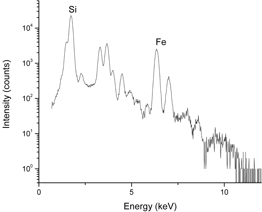- particle induced x-ray emission -
Allows the elemental characterization of samples by using an ion beam as an excitation source.
dating
morphology
technology
origin
composition
alteration

Ceramic

Glass

Metal

Mortar

Pigments

Stone
Ceramic Building Materials (CBM)
CBM can be indirectly dated and/or attributed to a geographic area Ceramic Building Materials (CBM)
Pigment identification on painted ceramic tiles can indicate the decoration technique used for their production.
Glass
Elemental analysis* of vitreous materials, i.e. medieval stained glass windows, especially focusing on inclusions and trace elements*, is helpful for provenance,production technology and indirect dating studies (glass from different historical periods has different elemental* composition).
Also PIXE depth profiles of light elements* (Na, Al, Si) are useful for identifying glass corrosion layers even where they are not visible otherwise (Weber et al., 2002).
Metals & Alloys
Applied for studying the composition of metals, alloys and for stratigraphic analysis of their corrosion patina.
Mortar & Plaster
Very effective, providing accurate elemental* composition knowledge of the binder and the aggregates of mortars and plasters (e.g. pozzolanic material) and of the nature of pigments of mural paintings and frescoes.
Pigments
The pigments used on painted building materials, as well as their weathering products, can be detected.
Stone
Comparison of PIXE spectra of unknown stone specimen with geological reference materials can be the key in historical stone authentication, provenance studies, etc.;
Also stone alteration or atmospheric deposition products, such as gypsum can be detected:.

PIXE spectrum. Image by Nora Pérez Castellanos.
Particle Induced X-ray Emission (PIXE) is a powerful non-destructive analytical technique used by scientists for determining and quantifying the elemental composition of cultural heritage materials, extremely sensitive to trace elements*, which are used as a fingerprint in Archaeometry. PIXE is often employed complementary to other chemical characterization techniques (Raman spectroscopy, XRD, ICP-MS, SEM-EDS) although most frequently it is combined with Proton Induced Gamma-ray Emission (PIGE), which allows probing a sample to a greater depth than PIXE.
The basic physical principle of PIXE is similar to that of the XRF technique; only the primary radiation source differs, but, has better detection limits and allows the identification of lighter elements than XRF. Produces a spectrum with concentration ratios of the elements.
accuracy
time
cost
in situ
invasive
destructive
The specimen is bombarded with an ion beam (usually photons of MeV energy) produced by a particle accelerator*. The ion beam interacts with the inner orbital of the sample’s atoms, ejecting electrons close to their nuclei (ionisation). The ejection of inner electrons creates vacancies which are covered by electrons from outer orbitals. As a consequence of these electronic transitions, X-rays with characteristic energies corresponding to the elements present in the material are emitted. The detector collects and measures the emitted X-rays, which are then converted into a spectrum.